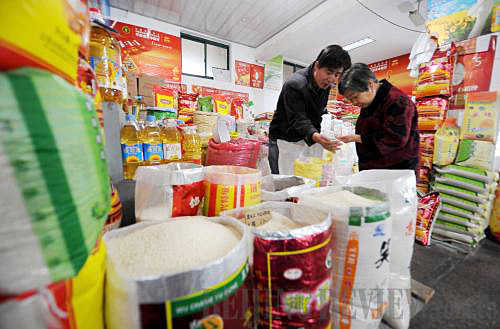|
 |
|
SAFETY FIRST: A buyer carefully chooses rice from a market in Hangzhou, east China's Zhejiang Province, on October 21, 2010 (HAN CHUANHAO) |
"Cadmium, arsenic and other heavy metals are often discharged with sewage by mining operations and make their way into rice paddies," Zeng said.
He said once the land was polluted, it could take about 10 years to restore it to the original state. The restoration techniques involve adding healthy soil on top of polluted land and using chemicals or microscopic organisms to make the soil less toxic. "We still don't have a very effective restoration technique," Zeng said.
Pan attributed the heavy metal pollution problem to China's current land contract system and farmers' self-supply of rice.
According to him, in Western countries, planting is done by farmers and large companies. Once the land is polluted, they may abandon it, while Chinese farmers have to bear the problem.
Also, Western countries usually ask the enterprises to pay funds for environmental protection and use the money to handle such problems, while the Chinese Government lacks such measures.
Also, he said, the lack of supervision allows the contaminated rice to make it to the market.
Steps taken
In order to tackle heavy metal pollution, the Ministry of Environmental Protection unveiled a long-awaited plan in February.
The plan was approved by the State Council, China's cabinet, as part of the country's 12th Five-Year Plan for National Social and Economic Development (2011-15).
The national plan set an emission-reduction target of 15 percent from the 2007 levels for five heavy metals in key polluted areas, said Environmental Protection Minister Zhou Shengxian at a televised conference. The metals are lead, mercury, chromium, cadmium and arsenic.
The first national pollution census, which was published in 2010, shows China discharged 900 tons of the five metals in 2007. More than 80 percent of the country's rivers, lakes and reservoirs, 63 percent of its coastal waters and about 20 million hectares of land were contaminated.
The breakneck expansion of heavy metal industries, outdated technology and a lack of effective monitoring are cited as the main reasons for pollution.
"More than 30 major heavy metal poisoning incidents have occurred since 2009, posing a grave threat to public health, especially to children," Zhou said.
The ministry listed 138 target zones in 14 provinces and regions, including Inner Mongolia Autonomous Region and Jiangsu and Zhejiang provinces.
A total of 4,452 enterprises, including nonferrous metal mines, smelters, lead-acid battery manufacturers, leather producers and those in the chemical industry, are listed as major monitoring targets.
The list was made after an intensive nationwide survey of more than 110,000 enterprises, conducted jointly by nine ministries at the end of 2010, according to Zhou.
Provincial governments are requested to work out their specific plans and targets by the first half of 2011. Local officials who fail to enforce the targets will be held accountable.
Zhou estimated a total of 75 billion yuan ($10.98 billion) over the next five years would be needed to address heavy metal pollution. The Ministry of Environmental Protection said it would invest in research and development of technologies for cleaning up heavy metals already in soil and water.
Zhou said tackling violations by battery manufacturers will be a major focus this year.
In the latest case in January, more than 200 children were found with excessive concentrations of lead in their blood in Huaining County, Anhui, the result of emissions from a nearby battery factory.
"Our investigation shows the enterprise faked environmental review documents, and the local government's lax monitoring was also to blame," Zhou said.
As a punishment, the ministry has suspended approval for any new projects involving heavy metal in Anqing City, which administers Huaining.
Appropriate systems for heavy metal pollution prevention, emergency response and environmental and health risk assessment would be in place by the year 2015, in order to resolve prominent issues putting the public's health at risk, Zhou said.
Meanwhile, local governments also vowed to take measures to solve heavy metal pollution.
At Hunan's 2011 Provincial Environmental Protection Work Meeting in late February, officials said over the next five years, 100 billion yuan ($14.64 billion) would be invested in environmental protection efforts in the province. Of that amount, more than 56 billion yuan ($8.2 billion) would go toward a concentrated effort to reduce heavy metal contamination.
The remediation plan for the Xiangjiang River was included in Hunan's 12th Five-Year Plan.
Anhui also pledged to take measures to crackdown on polluting enterprises.
"Enterprises like battery plants, which are prone to cause water pollution, will be shut down if they are not up to emission standards," said Miao Xuegang, Director of Anhui Provincial Environmental Protection Department, on March 9.
Furthermore, environmental authorities at provincial or prefecture levels will be responsible for monitoring enterprises and projects for heavy metal pollution, Miao said. That power used to be with lower-level governments.
According to Miao, more than 60 percent of enterprises discharging lead wastes in Anhui are not in conformity with required standards, which have put people's health at high risk.
"We must put in place a sound mechanism and strengthen supervision of projects that might affect people's health," Miao said. | 